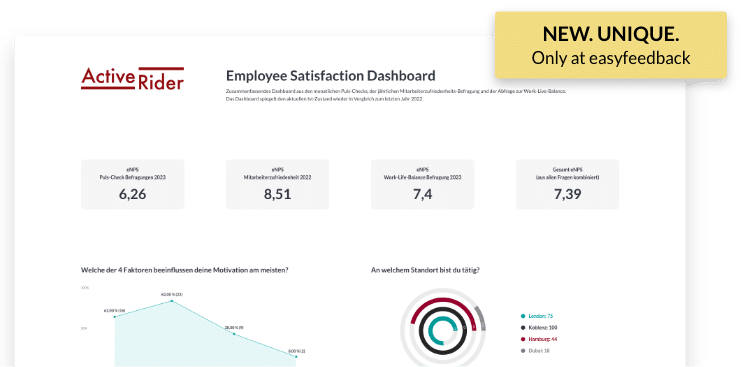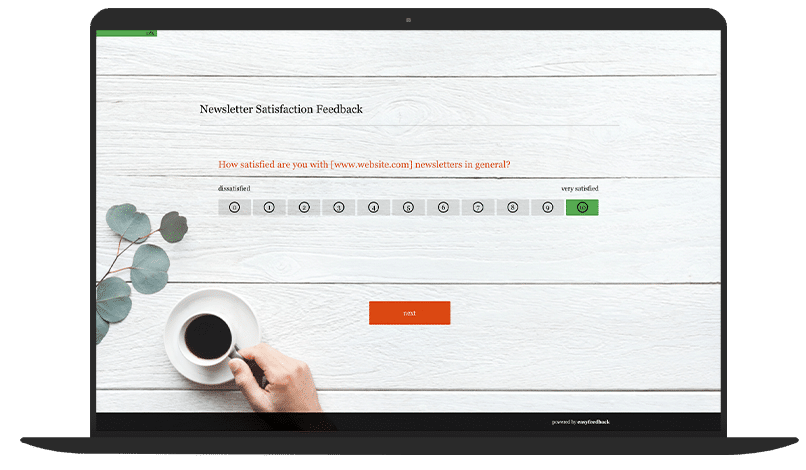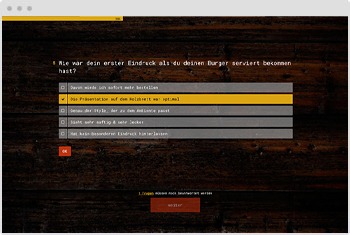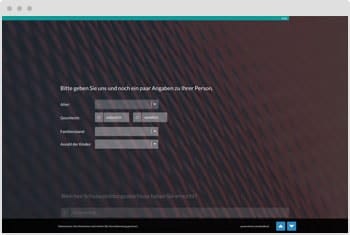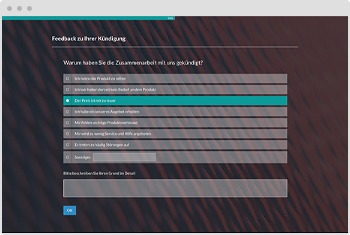Improve your newsletter sustainably with feedback from your readers

With this ready-to-use survey template, you will be able to improve the quality of your newsletter, thereby improving the connection with your customers and attracting new ones.

“Identifying customer needs is an essential part of our business. easyfeedback accompanies us for many years as a loyal partner in this task. We particularly appreciate the intuitive usability of the survey tool as well as the professional support.”
Guild Lead User Experience Research
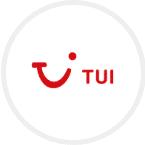
“We use easyfeedback for internal and external surveys – fast, comfortable and really easy! Straightforward and cordial support can always create a smile. We really appreciate the permanent development of the platform.”
Guest & Competitor Insights Analyst
Content and targets of this newsletter feedback template
Get to know your newsletter subscribers. Find out what layout and content will engage customers more effectively. Good newsletters sell products and are gladly opened.
Ask your customers about their wishes and needs for future newsletters, perhaps already at the next mailing. Customer feedback will enable optimizations for your newsletter marketing and your customers will notice the value of their opinion.
With increased newsletter quality and creativity, you will reach more customers. You can give the customer what they want.
Content:
• How often do customers want to read the newsletter
• When does he end his subscription
• What does the customer read
• What bothers the customer
• General feedback
Targets:
• Create effective newsletters
• Increase sales
• Retain customers
• Strengthen brand
• Use newsletters as a dialog tool
• Optimize newsletter marketing

Data privacy protection „made in Germany“ (GDPR)

Anonymity functions for open feedback
Almost everything you need to know about newsletter
1. What is a newsletter?
A newsletter is a regularly published circular that is usually distributed to a specific audience via e-mail. For example, the newsletter is aimed at customers or employees of a company and is sent out at certain intervals, for example weekly or monthly on a specific topic or subject area.
Since a newsletter is a flexible tool for communicating information, it can be used in different ways depending on the objective: Among other things, information about news such as discount promotions, new product releases or event offers can be distributed to customers in a targeted manner.
However, it is also suitable for communicating important company information to the company’s own employees. For example, internal company news or information about the planned employee survey can be communicated here.
2. What are the advantages of a newsletter?
A newsletter is a flexible and cost-effective marketing tool, which can be used very well for customer condition, but also for the acquisition of new customers.
Due to its digital nature, the newsletter is not only a cost-effective way to spread information to many people in a short time, but it can also go to exactly those people who have signed up for your newsletter without wastage.
Furthermore, the success of a newsletter can be measured quite easily. Key figures such as click, open or unsubscribe rates tell you how successful your newsletter is.
If implemented correctly and filled with content that meets expectations, it will bring your company traffic on all important company pages and can thus also contribute to an increase in sales.
3. How should a newsletter be structured?
Every newsletter should always be tailored to the respective company or the goal that is to be achieved with the newsletter. Include your corporate design, your company’s own style and use the newsletter to show who you are and what values you stand for.
However, there are a few general aspects that you can use as a guideline for the structure of your newsletter. We have summarized them for you below:
Sender and subject line
What is the first thing you see when you receive an email? That’s right, the sender and subject line. If the subject line piques your interest, open the mail. You realize what a big part the subject line plays in the success or failure of your newsletter. Accordingly, your attention should be focused on this component of the newsletter. Keep the subject short and concise and arouse the interest of your readers. Also, pay attention to your choice of words. Certain words will arouse suspicion of containing fraudulent or dangerous content and the mail will automatically end up in the recipient’s spam folder.
The sender also plays an important role. A mail with a personal sender or a clearly identifiable purpose (newsletter@beispiel.de) is more likely to be opened than a general (info@beispiel.de) or untrustworthy e-mail address (xyz34@beispiel.de).
Personal salutation
A personal salutation helps to increase customer loyalty. In addition, the reader feels directly addressed and is more inclined to continue reading. Depending on the company culture, a casual (Hey Tim) or a formal address (Dear Mr. Weber) is suitable.
The why?
Now we come to the core of the newsletter and the question of why it was sent in the first place. What do you want to achieve by sending the newsletter? Your goal could be, for example, to generate more traffic to your website or to stimulate sales. An incentive, for example in the form of a discount code, can help to arouse your readers’ interest and encourage them to read on.
Text part
In the text part, it is now a matter of positively influencing the reader in order to achieve the aforementioned why. Make sure that your text inspires not only in terms of design, but especially in terms of content. Meaningful headlines help you to structure your text. Even if a newsletter contains a series of mails, each mail should be unique. Therefore, avoid duplications and bring variety into it. For example, tell a personal story, give your readers an exclusive tip, or surprise them with added value, such as downloading a free e-book on a particular topic.
Call-to-action button
And now we come to the heart of the newsletter: the call-to-action button. After all, what good is a great newsletter if it’s read but there’s no subsequent reaction from the reader? Therefore, make sure that it is clearly visible and directs the reader to where you want them to go.
Greeting
Who is actually writing here? End your newsletter with a nice greeting and your name. A photo of you establishes a bond. This way, your readers have a picture of you right in front of them and know who to contact.
Footer
There are some legal aspects to consider in the footer. Among other things, it is mandatory that you refer to your imprint or name the address and corresponding contact options. In addition, you must give the recipient the opportunity to unsubscribe from the newsletter without much effort. Furthermore, you need a link to your privacy policy.
However, there is still room for your company logo or a link to your homepage.
4. What makes a good newsletter?
Good question! Good is what resonates with your readers. What works for one company doesn’t have to work for another. The content should reach your readers, inspire them and make them want more. How do you succeed in doing that?
Put yourself in your readers’ shoes. What is interesting to them, what can you help them with? What topics or problems are they concerned about?
In addition to the content, you should also consider external factors such as correct spelling and an appealing graphic design when structuring your newsletter. A text with little running space quickly looks squat and cluttered. Be careful not to use too much text and limit yourself to the essentials.
You can achieve a lot with colors and images and even convey moods.
But technical aspects should also be taken into account. The newsletter should display smoothly on both PC and mobile. All links should work and take the reader where he wants to go.
5. What makes a newsletter successful?
The purpose of a newsletter is to elicit interaction with the reader. A newsletter is “successful” in that it gets the reader to take action. We have listed three potential goals below:
1. The mail is opened
The first important success of a newsletter is that the mail is opened at all. If you have achieved this, that is already half the battle.
2. The newsletter is read
Another important factor is that the reader is interested in the content and reads the newsletter and does not unsubscribe immediately. In the best case, the reader can draw something valuable from it and will be open to subsequent mails.
3. The reader clicks on the call-to-action button
You have reached your goal. The reader takes action and follows the path you have provided, for example to a blog article on your website or to an offer in your online store.
6. How can easyfeedback help improve my newsletter marketing?
Have you always wanted to know what your readers think of your newsletter? What they would like to see or what could be improved? Then simply ask for feedback in your next newsletter.
Use a survey to find out how your readers like the design and content of your newsletter, whether it meets their expectations, and where there is potential for improvement.
With easyfeedback you can easily and quickly create your survey, customize it and easily place the survey link in your newsletter. Get valuable feedback in real time to offer your readers what you signed up for.
You are in professional company






easyfeedback welcomes more than 740.000 participants per month!
